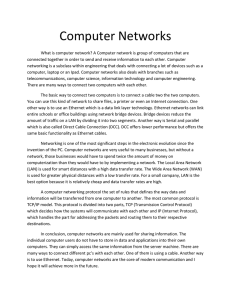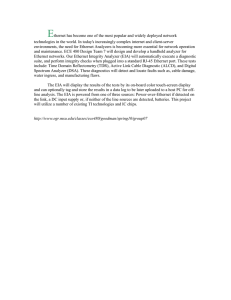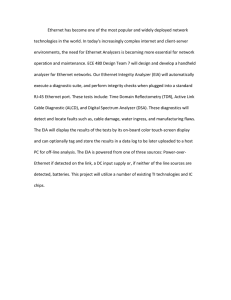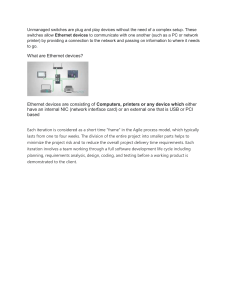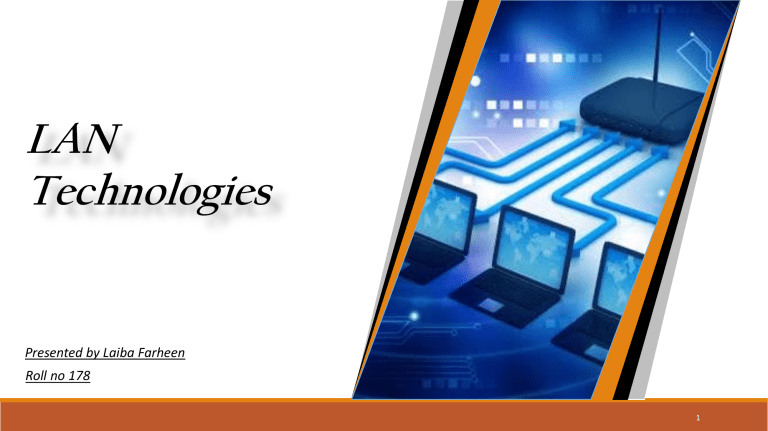
LAN Technologies Presented by Laiba Farheen Roll no 178 1 Introduction What is LAN LAN stands for local area network. It usually connects computers and peripheral devices in a small geographical area. It is the most common type of network. Networks in school, college and Office building. Hundred or thousand may be connected through LAN. Node 2 WLAN(wireless LAN) WLAN used for home and small office to connect laptop, printers, smartphone with a wireless router, which links them to the internet. Most common standard IEEE 802.1 also known as WIFI. Usually covers an area of 300 feet. 3 Features of LAN Technologies One copy of software can be shared by all users in a LAN. System resources like printers and hard disks can be shared between users. The data is more secured from being copied and destroyed. Data transmission speeds of LAN are typically from 10Mbps to 1000Mbps. 4 Types of LAN Technologies Ethernet Token Ring FDDI 5 Ethernet (IEEE 802.3) Most commonly used network standard in wired networks. The reason behind its wide usability is that it is inexpensive and easy to install and manage. Robert Metcalfe (Electrical engineer) 6 Ethernet (IEEE 802.3) It uses a high-speed network cable and bus topology. All the computers in Ethernet uses same cable to send and receive data. They must follow same rules for communication. Media access is controlled by a method called (CSMA/CD). It provide high data rates. 7 Ethernet Evolution Standard Ethernet Fast Ethernet Gigabit Ethernet 10 Gigabit Ethernet 8 Types of Ethernet Standard Ethernet It supports 10 Mbps transmission speed over twisted-pair cabling with a maximum length of 100 meters. The older 10 Mbps Ethernet is still used, but such networks do not provide necessary bandwidth for video applications. 9 Fast Ethernet The fast Ethernet (100BASE-T) is a type of Ethernet that can transfer data at the rate of 100 Mbps using a twisted-pair cable or a fiber-optic cable. Coaxial cable Fiber-optic cable Twisted-pair cable 10 Gigabit Ethernet The Gigabit Ethernet (1000BASE-T) is capable of transferring data at the rate of 1000 Mbps based on a twisted-pair or a fiber-optic cable, and it is very popular. The type of twisted-pair cables that support Gigabit Ethernet is CAT 5e cable and CAT 6 cable (UTP). CAT 6 cable CAT 5e cable 11 10 Gigabit Ethernet The 10 Gigabit Ethernet is a latest generation Ethernet capable of transferring data at a rate of 10 Gbps using CAT 7 Cable (STP) and fiber-optic cable. CAT 7 cable 12 Token Ring (IEEE 802.5) It was introduced by IBM in 1984, and standardized in 1989 as IEEE 802.5. Ring Topology is used. A token is a special frame of 3 bytes. Access control method used is Token Passing. Token ring is unidirectional. Data Rate is used from 4Mbps to 1Gbps. Piggybacking acknowledgement is used. Monitor station is used. 13 14 FDDI(Fiber Distributed Data Interface) was developed by the ANSI in the mid-1980s. It uses optical fiber as its physical medium. It is based on the token ring protocol. It contains two token rings. Primary ring is used for transmission of data while secondary ring is used for backup purpose. 15 16 It provide high data rate of 100 Mbps It can support thousands of users. Features It can extend in range up to 200 KM (124 miles). It can also be used as a backbone for WAN. 17 Thank You 18
